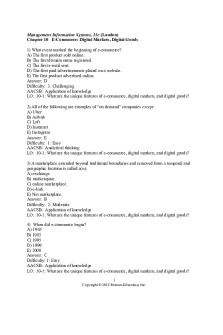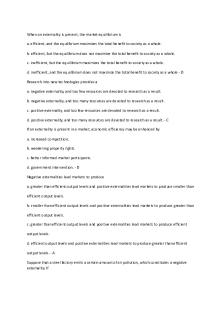Mark-305-quiz-2 (CHAP 8 to 10 ) PDF

| Title | Mark-305-quiz-2 (CHAP 8 to 10 ) |
|---|---|
| Course | Consumer Behaviour |
| Institution | Concordia University |
| Pages | 4 |
| File Size | 120.2 KB |
| File Type | |
| Total Downloads | 20 |
| Total Views | 149 |
Summary
questions for quiz 2...
Description
Mark 305 Quiz 2 Chapter 8 1. Describe the elements of the traditional communications model and explain how the updated model is different. Communications model specifies that a number of elements are necessary for communication to be achieved: -
A source must choose and encode a message: transfer meaning through representative symbolic images. Message is transmitted via a medium: there are the different ways available for passing on the message ex: billboard, tv, magazine. One or more receivers: they interpret the message based on their own experiences Feedback: goes back to the source and lets them know if the message they sent was understood.
Source message medium receiverfeedbacksource The updated model tries to pass on the messages to very small group of receivers, instead of using mass communication. It also considers the two-way communication between consumers and marketers, where consumer’s voices are heard, and their input help shape the messages they receive. 2. What is source credibility, and what are two factors that influence whether we will perceive a source to be credible? Source credibility refers to a communicator’s expertise, objectivity or trustworthiness. Consumer’s believe that these people will provide the necessary info needed to evaluate competing products. -
Source’s qualifications: is the source a good representative of the product, does it reflect the image the product wants ex: lebron james and nike
-
Source’s reporting bias: a consumer’s beliefs of a product attribute can be weakened if the source is perceived to be presenting biased info ex: tennis player gets paid for promoting a tennis racket
3. Should marketer ever try to arouse fear to persuade consumers? Yes, when the marketers are trying to convince consumers to change unwanted or unhealthy behaviours. Fear appeals are more effective when they only use a moderate amount of fear,
when the consumers are already afraid of the problem, and when a solution to the problem is presented. Chapter 9 1. List five types of perceived risk, giving an example of each. Perceived risk belief that the product has negative or uncertain consequences
2. List five product attributes that consumers can use as product quality signals and provide an example of each. When the information about a product is limited, People tend to associate the visible characteristics of a product to their quality, for example: -
The amount of time a manufacturer has been in business: the longer the better, more experience. - Well-known brand names: they are good, reputation, the best brands are the ones purchased the most. - Country of origin: acts as a stereotype, reputation the country has for the production of a given product ex: Italian shoes. Used when other type of information is unavailable or ambiguous - Price: you get what you pay for Greatly used for products that have wide quality variations ex: virgin wool - Retail outlets that carry the product.
3. Describe the difference between inertia and brand loyalty. Inertia is when a product is purchased out of habit, especially because it requires less effort. There is no commitment to the product and brand switching is easy. Whereas brand loyalty is a repeat-purchasing behaviour of the same brand, and it’s accompanied by a positive attitude towards the brand. Chapter 10 1. List five separate motivations for shopping, giving an example of each. -
-
-
Social experiences: people like to gather at shopping malls to spend their leisure time, they have different “attractions” like mini golf, carrousel ex: you go on a Friday afternoon to the mall with your friends Sharing of common interests: when people go to specialized stores and find people they share interests with ex: Sephora make up lovers Interpersonal attraction: is a secure environment for people to go and spend time Instant status: you feel good buying at a store because they make you feel like an important costumer ex: they remember your size, and know what you like from previous purchases The thrill of the chase: to see if they can find good prices or bargain.
2. List three factors that help to determine store image The store image is the personality a store has, and it can be placed anywhere from good to bad - Location - Merchandise suitability: do they meet the needs of the people - Knowledge and congeniality of sales staff 3. List three actions consumers can take if they are dissatisfied with a purchase Customers dissatisfaction is determined by the overall feelings about a product after it has been purchased. -
Voice response: consumer can appeal directly to the retailer for a refund, store credit Private response: when they express dissatisfaction to friends or boycott the store Third-party response: when they take legal action, write a bad review, register a complaint....
Similar Free PDFs

Mark-305-quiz-2 (CHAP 8 to 10 )
- 4 Pages

Bio2 Chapter 8 - Chap 8
- 2 Pages

Thought paper chap 8
- 1 Pages

William Roseberry-Chap 8
- 6 Pages

Chap 10. economics
- 15 Pages

chap 10 testbank
- 24 Pages

Chap 8 Lecture Notes
- 10 Pages

Econ 2100 chap 10
- 3 Pages

Chap 8 - Testbank
- 25 Pages

Notes Bioch - Chap 8
- 7 Pages

Chap 8 - Transport in Animals
- 13 Pages

Denise International Busine chap 8
- 38 Pages

Marketing research testbank Chap 10
- 13 Pages

Subnets and VLANs - chap 8
- 8 Pages
Popular Institutions
- Tinajero National High School - Annex
- Politeknik Caltex Riau
- Yokohama City University
- SGT University
- University of Al-Qadisiyah
- Divine Word College of Vigan
- Techniek College Rotterdam
- Universidade de Santiago
- Universiti Teknologi MARA Cawangan Johor Kampus Pasir Gudang
- Poltekkes Kemenkes Yogyakarta
- Baguio City National High School
- Colegio san marcos
- preparatoria uno
- Centro de Bachillerato Tecnológico Industrial y de Servicios No. 107
- Dalian Maritime University
- Quang Trung Secondary School
- Colegio Tecnológico en Informática
- Corporación Regional de Educación Superior
- Grupo CEDVA
- Dar Al Uloom University
- Centro de Estudios Preuniversitarios de la Universidad Nacional de Ingeniería
- 上智大学
- Aakash International School, Nuna Majara
- San Felipe Neri Catholic School
- Kang Chiao International School - New Taipei City
- Misamis Occidental National High School
- Institución Educativa Escuela Normal Juan Ladrilleros
- Kolehiyo ng Pantukan
- Batanes State College
- Instituto Continental
- Sekolah Menengah Kejuruan Kesehatan Kaltara (Tarakan)
- Colegio de La Inmaculada Concepcion - Cebu

